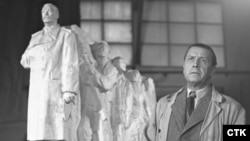From 1955 until 1962, the world's largest statue of Soviet dictator Josef Stalin loomed over the Czechoslovak capital, Prague. The 17,000-ton colossus dominated the skyline, impossible to miss. Yet the sculptor who designed the monument, Otakar Svec, never saw it.
For one day last month, the tyrant's giant head once again hung high above Prague, an essential character in the production of a new film relating Svec's personal tragedy.
"This monument destroyed its creator, broke his life," director Viktor Polesny told RFE/RL. "That is what our film is about -- about the situation into which this man fell and from which he could not escape."
Polesny's film, Monster, is based on the novel Granite Stalin by Czech writer Rudla Cainer.
The fate of sculptor Svec is similar to those of many Central European intellectuals from the generation born at the end of the 19th century that got caught up between the millstones of Hitler and Stalin.
He was born in Karlovy Vary in 1892 and began his career as a sculptor after World War I. Besides the Stalin tribute, he is most famous for a futuristic sculpture called Sunbeam Motorcyclist, as well as for monuments to Czech historical figures including Holy Roman Emperor Charles IV, first Czechoslovak President T.G. Masaryk, and doomed Christian reformer Jan Hus.
His Masaryk statue, which commanded a view of Prague from the same spot where the Stalin monument later would, was destroyed after Hitler occupied and partitioned Czechoslovakia.
Svec kept a low profile after the communists took over Czechoslovakia and the country was absorbed into the Soviet orbit. "He was a complicated person, like the majority of artists," Polesny says. "Essentially, he was a man of the First Republic [the independent Czechoslovak state between the world wars]. He was not a communist."
Destroyed By 'The Monster'
In 1949, however, Svec was invited to participate in the competition for the Stalin monument. Certain that the honor would go to one of the regime's favorite artists, Svec submitted a design that he hoped would bring him some benefits as a runner-up.
"He was hoping there would be some honorarium, some commissions, some success, but he never expected victory and all its consequences," Polesny says.
It took more than five years to build the huge construction, which featured the gigantic Stalin at the front of a group of proletarian workers. Czechs soon took to referring to the composition as a "queue for meat."
The construction period was traumatic for Svec. "When he was forced to build the monument, he fell into depression, which was perfectly logical," Polesny says. "He 'treated himself' with alcohol, which also was a common practice. He had a romantic affair at the time, which also played a role. His wife -- who worked with him on the monument -- learned about it. Everything was headed toward disaster. His personal, family tragedy unfolded against the background of the huge public spectacle that the regime made of the unveiling."
"My film, essentially, is about this psychological drama, about a man trying to resolve an unresolvable situation," he adds.
In 1954, apparently from a combination of political pressure and personal drama, Svec's wife, Vlasta Svecova, committed suicide.
As the monument neared completion in the spring of 1955, Svec also took his own life on April 4. No one knows for sure exactly why or how.
The Monument No One Wanted
The Stalin monument was finally unveiled on May 1, 1955, more than two years after the dictator himself had died.
"By the time it appeared, the monument was already out of date," Polesny says. "In 1955, it was unveiled. In early 1956, [Soviet leader Nikita] Khrushchev addressed the 20th congress of the Soviet Communist Party with his denunciation of Stalin."
"But the Stalin monument stood in Prague for nearly seven years," he adds. "No one ever needed it."
In 1962, it took more than 800 kilograms of explosives to destroy the "monster."
Polesny began working on the Svec project more than five years ago, but now -- with a strong push to rehabilitate Stalin in the Russia of Vladimir Putin and among his followers in other countries -- the topic is surprisingly appropriate.
"To be honest, I never connected my idea with anything in the real political or international arena," Polesny says. "If now some moments and ideas from this film are beginning to seem realistic, that has nothing to do with me. The times are just like that."


